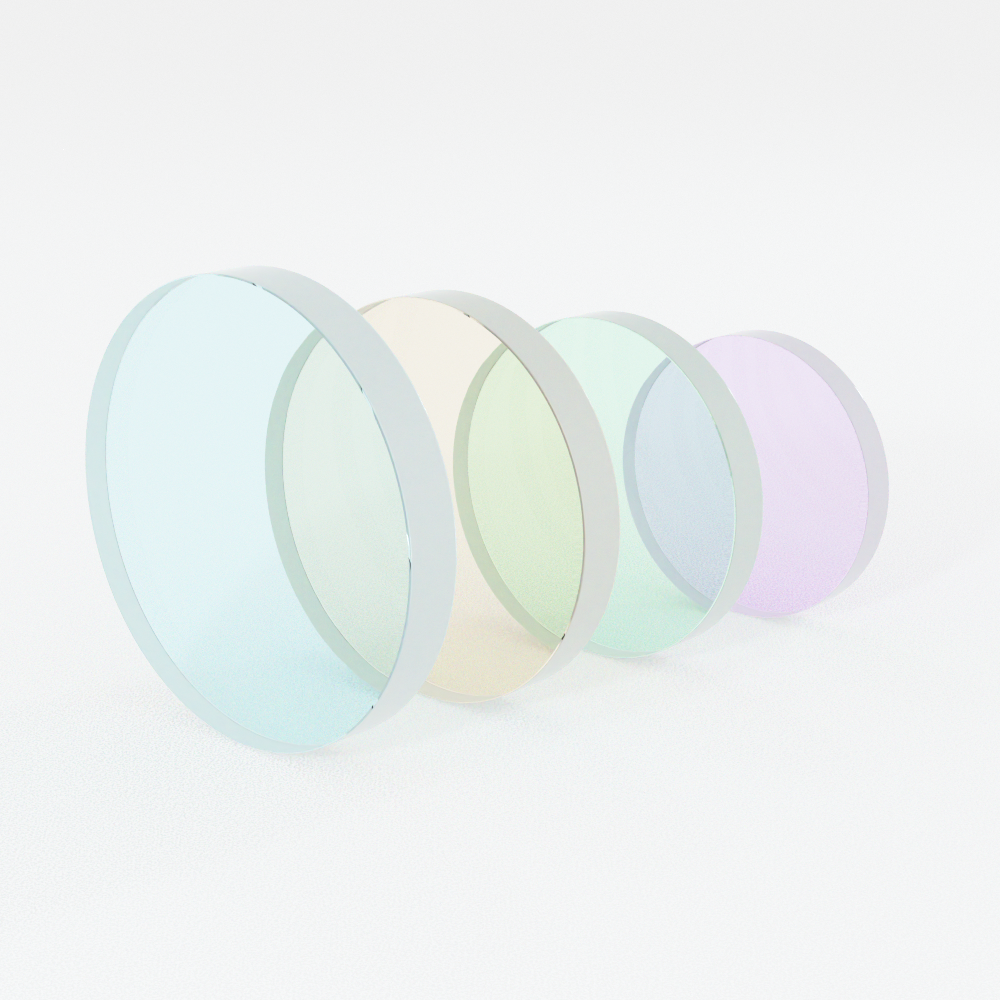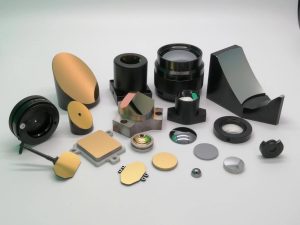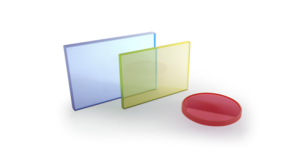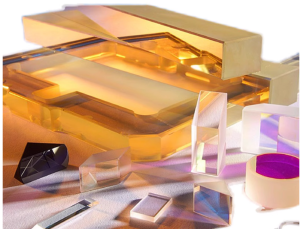
Colorless Optical Glass
Optical glass is the foundation and important part of photoelectric technology industry, and its components are the key components in optical instruments. In a narrow sense, optical glass refers to colorless optical glass.
Classification of optical glass grades
According to refractive index nd and dispersion coefficient υ D in Nd- υ D. the position and glass composition in the field diagram. Colorless optical glass is divided into 16 categories according to table 1.
Table 1
glass category name code glass category name code
Fluorine crown glass FK light flint glass QF
Light crown glass QK flint glass f
Crown glass K barium flint glass BAF
Phosphorus crown glass PK heavy barium flint glass ZBAF
Barium crown glass bak heavy flint glass ZF
Heavy crown glass ZK lanthanum flint glass LAF
Lanthanum crown glass LAK heavy lanthanum flint glass zlaf
Coronal flint glass KF special flint glass TF
Designation of optical glass
Each optical glass brand is composed of the code of the glass category name and the serial number. In addition, six digits are used as the code to characterize each brand. The first three digits represent the three digits after the decimal point of the refractive index of the brand glass, and the last three digits represent the Abbe number of the brand glass. For example: h-k9l, nd = 1.51680, υ D = 64.20, its code is 517642.
Designation of lead, arsenic and cadmium free glass grades
The glass brand without lead, arsenic, cadmium and other radioactive elements uses the initials “H” of the Chinese phonetic alphabet of the word “ring”
Add “-” as a prefix. For example: h-k9l.
Designation of glass grades with low softening point
The brand of low softening point glass without lead, arsenic, cadmium and other radioactive elements used for molding is “low”
The initial consonant “d” plus “-” of the phonetic alphabet is expressed as a prefix. For example: d-k9l.
Naming of high permeability glass grades
The brand of UV high permeability glass is named according to the original custom, and is prefixed with the initial letter “U” of the word “ultraviolet”; For example: uqf50. High transmittance glass is the beginning of the word “high transmittance” after the serial number of the brand
The letter “HT” indicates; For example: zf7lht.
optical performance
Refractive index
The refractive index of each brand of optical glass is given with 5 decimal places according to the 12 spectral lines listed in Table 2. The precise measurement of the refractive index of these spectral lines is carried out according to the test method of GB / T 7962.11, and the measurement accuracy is ± 3 × 10-6。
Dispersion and Abbe number
The central dispersion is NF NC or NF ‘- NC’.
Dispersion coefficient (Abbe number) υ D is defined as follows:
υ d=(nd-1)/(nF-nC) ………………………(1)
Also listed υ E is
υ e=(ne-1)/( nF′-nC′)……………………(2)
Dispersion formula
In the spectral range of 365 ~ 706.5nm, if it is necessary to know the refractive index of other wavelengths, it can be calculated by the following dispersion formula:
n2=A0+A1 λ 2+A2 λ- 2+A3 λ- 4+A4 λ- 6+A5 λ- 8 ……………………………(3)
Where: A0 ~ A5 – Calculation constant (varies with glass brand and is listed in the performance data sheet of each brand respectively);
λ— Wavelength, μ m;
N – refractive index, n calculation accuracy: ± 3 in the range of 400nm ~ 706.5nm × 10-6; ± 5 in the range of 365nm ~ 400nm × 10-6。
Relative partial dispersion
For the relative partial dispersion PX of wavelengths X and y, y is expressed by the following formula:
PX,Y =(nx-ny)/(nF-nC)
P′X,Y=(nx-ny)/(nF′-nC′) …………………………(4)
The values of PD, C, PE, D, PG, F and P ′ D, C ′, P ′ e, D ′, P ′ g and f ′ are given in the data sheet according to the brand.
According to Abbe’s formula, for most so-called “normal glass”, the following linear relationship is true:
PX,Y=mX,Y υ d+bX,Y ………………………………………(5)
This linear relationship takes PX and y as ordinates, υ D is represented by abscissa. Where MX and y are slope, BX and y are intercept.
As we all know, the correction of secondary spectrum, that is, achromatic aberration of more than two wavelengths, requires at least one method that does not conform to formula (5)
Glass (i.e. its PX and Y values deviate from Abbe’s empirical formula). The deviation value is Δ Px, y means, then each Px, y- υ Point D is shifted relative to the “normal line” according to formula (5) Δ Px, y quantity. In this way, all kinds of glass brands Δ The values of PX and y can be calculated by the following formula:
PX,Y=mX,Y υ d+bX,Y+ Δ PX,Y ……………………………………(6)
therefore Δ PX and Y quantitatively represent the deviation characteristics of special dispersion compared with “normal glass”.
We choose h-k6 and F4 as “normal glass”, and the relative partial dispersion and Abbe number of h-k6 and F4 conform to Abbe formula (5).
The data sheet is given by brand Δ Pg,F、 Δ PF,e。 Their calculation formula is as follows:
Δ PF,e=PF,e-0.4894+0.000541 υ d
Δ Pg,F=Pg,F-0.6457+0.001703 υ d …………………………(7)
Stress optical coefficient b
Mechanical stress in glass can lead to birefringence of light. The stress optical coefficient represents the relationship between the effective stress and the optical path difference generated by stress birefringence:
δ= B·d·F ………………………………………(8)
Where: δ— Optical path difference, nm;
B – stress optical coefficient, / PA;
D – distance of light passing through the glass, cm;
F – pressure stress, PA.
Internal transmittance τ
The internal transmittance is the transmittance when the reflection loss of the sample surface is not included. Measure according to the method specified in GB / T 7962.12. The data table shows the transmission ratios of 5mm and 10mm thick glasses of various brands at different wavelengths.
Coloring degree( λ 80/ λ 5)
Chromaticity for transmission spectral properties of optical glass( λ 80/ λ 5) The thickness of the sample is 10mm ± 0.1mm, λ 80 is the corresponding wavelength when the transmittance of glass reaches 80%, λ 5 is the corresponding wavelength when the transmittance of glass reaches 5%. And expressed in 10nm. For example, when the glass transmittance reaches 80%, the corresponding wavelength is 368nm, when the glass transmittance reaches 5%, the corresponding wavelength is 313nm, and the chromaticity is low λ 80/ λ 5 is 37 / 31.
Chemical properties
The ability of the polished surface of optical glass element to resist the action of various corrosive media in the process of manufacturing and use is called the chemical stability of optical glass.
Stability against humid atmosphere RC (s) (surface method)
It is divided into three levels according to the stability of the action on humid atmosphere:
Grade 1 – when the temperature is 50 ℃ and the relative humidity is 80%, the time for the formation of hydrolysis spots on the polished glass surface exceeds 20h;
Grade 2 – under the same test conditions, the time of forming hydrolysis spots is between 5h and 20h;
Grade 3 — under the same test conditions, the time for the formation of hydrolysis spots is less than 5h.
Acid resistance stability RA (s) (surface method)
According to the stability of acid solution, it is divided into three levels:
1-Under the action of 0.1N acetic acid solution at 50 ℃, the damage depth of glass polished surface reaches 135nm for more than 5h;
2-under the same test conditions, the time of failure depth up to 135nm is 1H ~ 5h;
3 — under the same test conditions, the time for the failure depth to reach 135nm is less than 1h.
Water resistance stability DW (powder method)
According to the test method of GB / T 17129, calculate according to the following formula:
B-C
Dw= × 100 ………………………………………(9)
B-A
Where: DW glass leaching percentage,%;
B mass of filter and sample, G;
C mass of filter and sample after leaching, G;
A filter mass, G.
According to the calculated leaching percentage, the water resistance stability DW of optical glass is divided into 6 categories.
Acid resistance stability Da (powder method)
According to the test method of GB / T 17129, calculate according to the following formula:
B-C
D= × 100 ……………………………… (10)
A B-A
Where: Da glass leaching percentage,%;
B mass of filter and sample, G;
C mass of filter and sample after leaching, G;
A filter mass, G.
According to the calculated leaching percentage, the acid resistance stability Da of optical glass is divided into 6 categories.
Thermal Properties
Coefficient of thermal expansion α
The coefficient of thermal expansion of optical glass refers to the elongation per unit length of glass when the temperature rises by 1 ℃ within a certain temperature range.
The average thermal expansion coefficient of glass is measured according to the method specified in GB / T 7962.16.
Transition temperature Tg
Optical glass will gradually change from solid state to plastic state in a certain temperature range. The transition temperature Tg refers to the temperature corresponding to the intersection point of the extension straight line part of the low-temperature region and the high-temperature region of the glass sample from the room temperature to the sag temperature ts, as shown in Figure 2. Measure according to the method specified in GB / T 7962.16.
Sag temperature TS
The sag temperature TS refers to the temperature at which the glass sample stops expanding during the heating process. According to GB / t7962 sixteen
Measure according to the specified method.
Δ L
+100℃~+300℃
+20℃~+120℃
Tg Ts T
Strain point t1014. five
The strain point is the temperature at which the glass viscosity is 1014.5d PA · s (or 1013.5pa · s). That is, the temperature at which the stress in the glass can be eliminated within a few hours.
Annealing point T1013
The annealing point is the temperature at which the glass viscosity is 1013 DPA · s (or 1012 PA · s). That is, the temperature at which the stress in the glass can be eliminated in a few minutes, that is, the upper limit temperature of glass annealing.
Mechanical properties
Young’s modulus E, shear modulus G and Poisson’s ratio μ
Young’s modulus, shear modulus and Poisson’s ratio of optical glass are calculated according to the following formula:
ρρ× − ×× −=2234llVGVGGE ……………………………………………(11)
………………………………………………………(12) ρ×= 2sVG
12−=GE μ ……………………………………………………… (13)
Where:
E – Young’s modulus, PA;
G – shear modulus, PA;
μ— Poisson’s ratio;
V L – longitudinal wave velocity;
Vs – shear wave velocity;
ρ— Glass density, g / cm3.
Knoop hardness HK
Knoop hardness shall be measured according to the test method specified in GB / T 7962.21. The method adopts a symmetrical edge angle of 172 ° 30 ‘and
Apply a certain load to the 130 ° pyramid diamond indenter and press it vertically on the sample. After holding it for a certain time, remove the load, observe and measure the length of the long diagonal of the indentation on the sample with a microscope, and calculate the Knoop hardness according to the following formula:
HK = F/(0.07028·L2) ………………………………………(14)
Where:
F – load, N;
L – length of long diagonal of indentation, m;
HK Knoop hardness, PA.
Abrasion degree fa
Abrasion degree refers to the ratio of the wear reduction of the sample to the wear reduction (volume) of the standard sample multiplied by 100 under the same conditions, which can be expressed by the formula as follows:
W/ ρ
FA = × 100 ………………………………………………(15)
W0/ ρ 0
Where:
FA: abrasion degree
W: Wear reduction mass of sample, G;
W0: wear reduction mass of standard sample, G;
ρ: Density of sample, g / cm3;
ρ 0: density of standard sample, g / cm3.
density ρ
The density of optical glass refers to the mass per unit volume below 20 ℃. The density of optical glass shall be measured according to the method specified in GB / T 7962.20. The unit is expressed in g / cm3.
Glass quality index
Refractive index nd and Abbe number υ D. allowable deviation
Refractive index nd and Abbe number υ D the allowable deviation from the standard value is divided into three levels, as shown in Table 5
The refractive index and Abbe number of optical glass shall be measured according to the test method specified in GB / T 7962.1. The refractive index measurement accuracy is
±3 × 10-5, the measurement accuracy of middle dispersion is ± 2 × 10-5。
Optical uniformity
6.2.1 glass blank with size less than 150mm
The optical uniformity of glass blanks with size less than 150mm shall be measured according to the test method specified in GB / T 7962.2. The method is specified according to the change of the resolution of the device caused by the glass sample placed in the collimator beam. If the parallel tube is given with theoretical resolution α 0, and when the glass sample is placed, the resolution increases to α, Then the non-uniformity of glass can be determined by its ratio α/α 0, divided into 4 levels, see Table 6.
6.2.2 glass blanks with size greater than 150mm
The optical uniformity of glass blanks with a size greater than 150mm is the maximum refractive index deviation of each part of a glass Δ Nmax, measured according to the test method specified in GB / T 7962.4, divided into four levels, as shown in Table 7.
Middle stress
The stress birefringence of glass blank is based on the optical path difference per unit length in the middle of the longest side δ Indicates that it is measured according to the test method specified in GB / T 7962.5 and is divided into 5 levels.
Edge stress
The stress birefringence of glass blank is the maximum optical path difference on the unit thickness at 5% diameter or side length from the edge δ Max means that it is measured according to the test method specified in GB / T 7962.6, which is divided into five levels.
Fringe degree
The fringe detector composed of point light source and lens is used to compare with the standard sample in the direction where the fringe is most easily seen, which is divided into three levels.
Bubble degree
The bubble quality of optical glass shall be measured according to the test method specified in GB / T 7962.8. The allowable bubble content grade in glass is determined by the bubble (diameter) contained in 100cm3 glass φ The total cross-sectional area of ≥ 0.052mm is determined as 0.05mm. Stones, crystals and other inclusions are also calculated as bubbles. The arithmetic mean of the longest axis and the shortest axis is taken as the diameter of the flat bubble to calculate the cross-sectional area.
Light absorption coefficient
The light absorption coefficient shall be measured by spherical photometer according to the test method specified in GB / T 7962.9, and the light absorption coefficient of glass, etc
The ratio of the white light flux absorbed by the glass on the 1cm optical path to the incident light flux before entering the optical path is divided into 8 levels.
Radiation performance
Class I pair γ Optical glass with stable (non discoloration) radiation is called radiation resistant glass. This kind of glass is melted by adding a small amount of other oxides on the basis of the formula of ordinary optical glass. Therefore, they have the same optical constant value corresponding to ordinary optical glass, and their brand number is composed of the corresponding ordinary optical glass brand number plus 500. For example, K9 glass, whose corresponding radiation resistant glass brand is k509.
The radiation resistance of radiation resistant glass is measured with a dose of 105r (i.e. 25.8c/kg) γ Ray radiation, optical density increment per cm thickness Δ D, or the optical density increment per centimeter thickness after X-ray radiation equivalent to the above dose Δ D1.
Supply form
Optical glass block
The two sides are finely ground, the other four sides are roughly ground, and the edges and corners are slightly chamfered, which is subject to fine annealing.
Optical glass strip
The cut section is a natural transparent surface, and the other four sides are naturally formed surfaces, which are subject to rough annealing or fine annealing.
Optical glass preform
Primary molding blank of optical glass
The primary molding blank is the blank formed by direct drop pressing through smelting and fine annealing.
Optical glass secondary molding blank
The secondary pressing blank is processed again, hot pressed and annealed. See table 14 for specification and dimensional tolerance.
Optical glass fruit material (or gobs material)
Fruit shaped material (or gobs material) is a kind of blank with almost circular cross-sectional area. The weight or volume is determined according to the needs of customers without fine annealing.
Mutual search directory
The same brand in the mutual search table of optical glass in this catalogue only means that the glass code composition is equal, while the glass components cdgm, Hoya, Ohara, Schott and sumita are different.
End



